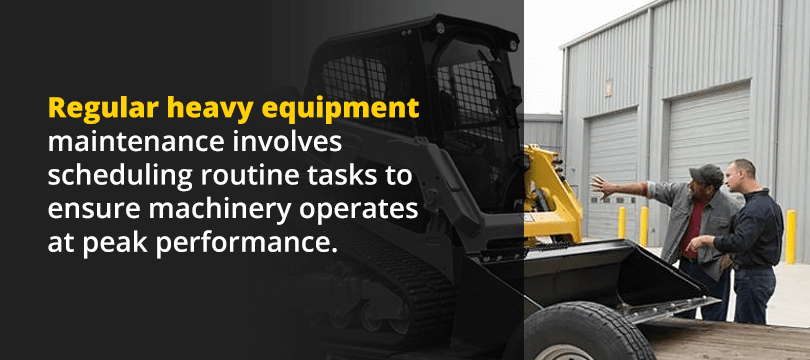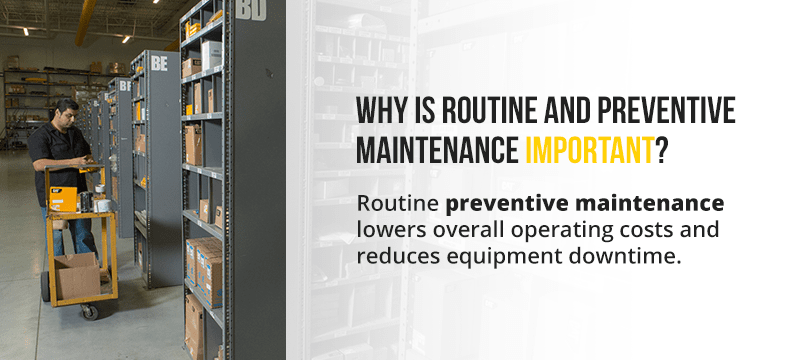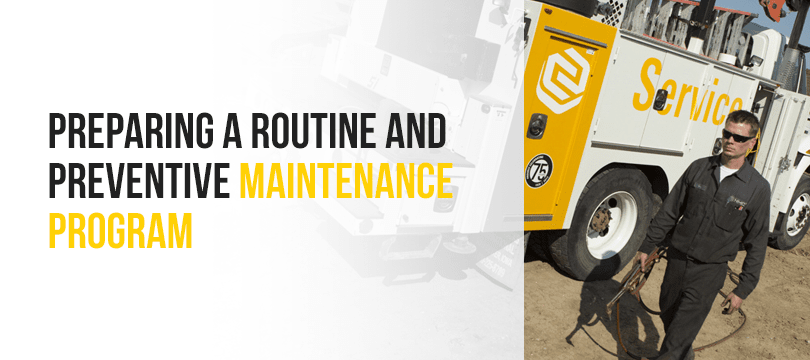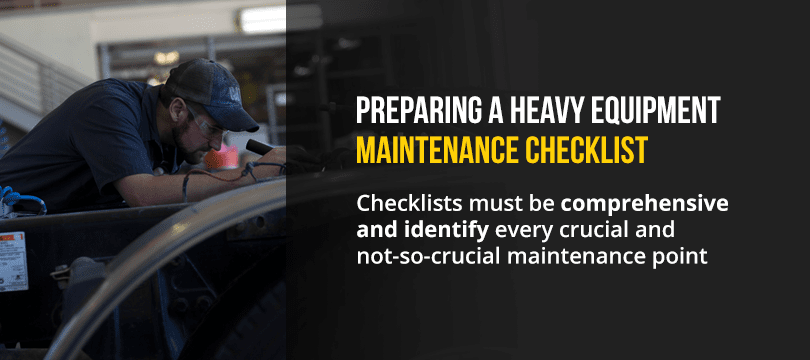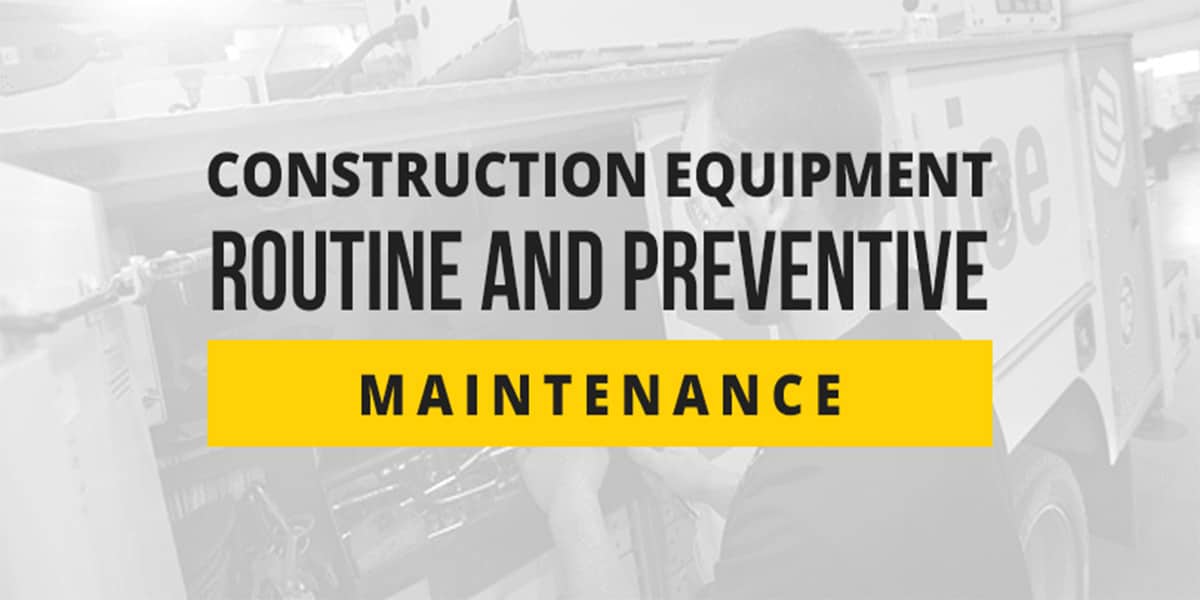
Construction Equipment Maintenance
Category: Equipment and Solutions
Everyone in the construction equipment business knows the old sayings “an ounce of prevention is worth a pound of cure” and “a dime of routine and preventive maintenance is worth a dollar in repairs.” And then there’s the adage, “If it ain’t broke, don’t fix it.” The first two are true, but the last phrase should be the furthest thing from a construction equipment service person’s mind.
Routine maintenance and preventive maintenance go hand-in-hand. They’re extensions of the same term. Both aim at keeping equipment running smoothly and avoiding costly repairs that suddenly take it out of service. We believe preventive maintenance goes further than routine and scheduled tasks. Service technicians and mechanics often anticipate potential problems and nip them before serious damage occurs.
Construction equipment maintainers look at repair work as proactive and reactive. They also call it scheduled and unscheduled repairs. Proactive maintenance is far more cost-effective than reactive, post-breakdown repair. Routine and preventive maintenance saves construction companies enormous sums compared to suffering expensive parts replacement and costly downtime when unexpected failure suddenly happens.
What Is Routine and Preventive Maintenance?
Regular heavy equipment maintenance involves scheduling routine tasks to ensure machinery operates at peak performance. Preventive maintenance also involves visual inspections, technical monitoring and oil analysis to anticipate problems and fix them before they become serious. Every regular maintenance step should be a routine part of a company’s preventive maintenance plan.
Routine is the key word in every preventive maintenance program. Performing routine tasks like oil changes, lubrication and tire or track inspections are part of a regular heavy equipment maintenance program. There’s more to a thorough and comprehensive maintenance plan. It involves detailing routine tasks on a construction equipment preventive maintenance schedule so they won’t be overlooked at specific milestones.
Preventive maintenance takes a team approach to maintaining equipment. It involves following the original equipment manufacturer’s recommendations as well as applying what a specific company’s experiences tell it about a particular piece of machinery. Effective preventive maintenance also includes input from operators and front-line mechanics. No one knows equipment better than the people who build it, run it and repair it.
Why Is Routine and Preventive Maintenance Important?
Preventively maintaining equipment is vital for a lot of reasons. Primarily, routine preventive maintenance lowers overall operating costs and reduces equipment downtime. Regular repairs and up-keep prevent parts and components from excessive wear and sudden failure.
Every operator and mechanic knows that catastrophic failure can set off a chain of events that damages other equipment parts. What could have been an inexpensive part replacement at an early intervention stage would have prevented a complete system failure like a blown engine or ruptured hydraulics. Expensive downtime always accompanies extensive downtime. Many experienced mechanics in the equipment maintenance field say repair costs and downtime length are directly proportional.
Preventive and routine maintenance maximizes a company’s equipment availability and lowers overall expenses. It makes equipment safer, extends service longevity and enhances operator confidence. A proper preventive maintenance program also reduces the chance of costly litigation. Here’s a closer look at why routine and preventive maintenance is so important:
- Availability: When equipment suddenly fails, there’s no choice but to pull it from service. That leaves the machine unable to perform its task and support other machinery on the job. It also leaves a paid operator sitting idle. Unavailable machinery costs money. It doesn’t make money until it’s fixed and back to work. Good preventive maintenance makes sure equipment is always available except for scheduled servicing.
- Expenses: Unexpected breakdowns aren’t planned events. Nor are they planned expenses. Every profitable heavy equipment company works with budgets. Scheduled routine and preventive work fits into a budget and is anticipated. Sudden breakdowns often go beyond budget allowances. Repair costs added to lost income due to equipment unavailability compound into pricey expenses that may have been avoided with routine maintenance.
- Safety: Reliable machines are safe machines. Making sure all construction equipment is routinely repaired and maintained in excellent condition significantly adds to its safety. Sudden component failure can cause dangerous conditions to workers as well as presenting unsafe environmental hazards. Keeping construction equipment safe is part of a preventive maintenance program.
- Longevity: Without question, properly maintained construction equipment outlasts poorly maintained machinery. Good maintenance extends service longevity. It also pays returns in resale and trade-in value. Equipment works longer and makes more income during its service. Then, if well maintained, that equipment is worth more money at its end.
- Confidence: Like construction equipment, machine operators are valuable assets. However, operators are humans and have emotional needs. One of those is having confidence that the equipment they’re handling is safe and dependable. Poorly maintained equipment has a demoralizing effect on operators, and soon they’ll develop a lack of confidence that leads to company disrespect. That spirals to a lack of safe operation or failure to report potential problems. You can prevent low confidence with routine maintenance.
- Litigation: No matter how well maintained construction equipment is, sometimes accidents happen. When they do, it invariably involves the authorities and investigations into the cause. If the mishap occurred because of negligence due to poor maintenance, that would bring liability onto the equipment owner. It could lead to litigation. However, if there is a clear trail of regular and preventive maintenance, the chance of expensive litigation significantly lowers.
A proper routine and preventive maintenance program improves availability and lowers overall expenses. It makes equipment safer, encourages operator confidence and maximizes longevity. Maintaining equipment properly also reduces litigation risk. A thorough routine and preventive maintenance program achieves every point.
Preparing a Routine and Preventive Maintenance Program
Preparing an effective and comprehensive routine and preventive maintenance takes dedication and commitment. It’s an on-going activity that isolates tasks peculiar to maintaining specific machinery pieces based on their unique requirements. Although many routine tasks have general characteristics, a thorough program is all-inclusive. It covers every anticipated problem by prescribing a preventive solution.
The best way to prepare a preventive maintenance program is to understand what makes for an effective plan. There’s a lot of information available on the internet or through conventionally published sources. That’s helpful but can be overwhelming in complexity and technicalities. It doesn’t have to be. Preparing a good equipment maintenance plan simply involves asking five questions and fleshing out the answers. Those questions are:
- What should a preventive maintenance program cover?
- Who should be responsible for administering the plan?
- When will servicing intervals or milestones happen?
- How should documentation be done?
- Where is clear and pertinent information available?
1. What Should a Preventive Maintenance Program Cover?
Routine and preventive maintenance programs cover three primary components. First is routine scheduling for mandatory service tasks like lubrication and oil or filter changes. This also takes in fluid analysis, which is one of the most important tasks in all equipment servicing. Second, visual inspections are vital. They take maintenance beyond being routine and turn them proactive. The third component is proactively replacing parts. Mechanics identify parts showing wear or reaching the end of anticipated life. They’re replaced before they cause problems.
2. Who Should Be Responsible for Administering the Equipment Maintenance Plan?
Responsibility for administering a preventive maintenance plan depends on a company’s size. Small operations with hands-on ownership often have the principal overseeing the program. Larger operations usually delegate administration to a fleet manager or head technician. The best choice is always someone who knows the equipment and has the dedication to see the plan succeed.
3. When Will Servicing Intervals or Milestones for Equipment Happen?
Servicing milestones and intervals are moving targets. They’re highly dependent on variable factors like seasonal changes, working environments and equipment operation time. The best advice comes from a combination of the machinery owner’s manual and the experience of on-site operators and maintainers. Often milestones include:
- Engine running hours
- Traveling distance in miles
- General equipment condition and age
4. How Should Documentation of Equipment Maintenance Be Done?
Documentation has never been easier thanks to modern technology. Computer programs and interactive software make it easy to accurately monitor equipment and predict when servicing is necessary. Historical data also identifies potential failures because of similar equipment incidents. Documentation is a highly important part of an equipment maintenance program because it allows for accurate planning. It also produces accurate reports when necessary for inspections or defending litigation.
5. Where Is Clear and Pertinent Equipment Maintenance Information Available?
Finding information sources on maintenance for construction equipment can feel overwhelming. To start with, the original equipment manufacturer is an excellent information provider with specifications and schedules for required maintenance. Internet sites from industry organizations are another great source for supporting maintenance plans. Many sites have templates to use for implementing a program.
However, the best place to start with is within the company. That’s by involving your equipment operators, technicians and mechanics. Together, they’ll develop the best tool in the preventive maintenance program, a heavy equipment maintenance checklist.
Preparing a Heavy Equipment Maintenance Checklist
Checklists must be comprehensive and identify every crucial and not-so-crucial maintenance point that’s unique to a particular equipment piece. They cover what should be done and at what recommended time. They also remind maintainers to anticipate developing problems so they can take counteractive measures before something fails.
Although checklists are designed for thoroughness, they’re not meant to be how-to or instructional guides. Rather, effective checklists have itemized points that remind a maintainer to pay attention to all details. Checklists don’t have to be complicated, but they are indispensable in every construction equipment regular and preventive maintenance program. Here are common tasks found on a heavy equipment maintenance checklist:
- Batteries: Batteries notoriously lose charge or die on short notice. Checklists should include a battery’s age, its voltage retention and acid ratio. Also important are the terminal and cable conditions.
- Belts: Most construction equipment has belt-driven components like compressors, alternators and pumps. Belt age, fraying, slackness and discoloration should be on an equipment list.
- Body: Inspect and record general body condition with a checklist. Note the damage, rust, looseness and paint conditions.
- Brakes: Brake condition should be near the checklist top. Pad and shoe status, as well as drum and disc health, are crucial observations. So are fluid levels, pressures and cable conditions.
- Coolant: Radiator and transmission coolants tell a lot about equipment’s state. Aside from adequate levels and normal colors, coolants should have periodic analysis to check for internal problems that can’t be detected by the eye.
- Electrical: Electrical component checkpoints go beyond battery conditions. Checklists should include voltage and amperage testing, cable examination and fuse conditions.
- Exhaust: Exhaust systems tell a lot about engine performance. Abnormal sound is one problem indicator but so is smoke. Exhaust connections like clamps and hangers should have their own checklist boxes.
- Filters: Every filter on the equipment must have its own check-off. That includes oil, fuel, air and hydraulic filters. It could also be cabin filters. Checklist remarks can include whether filters were cleaned or replaced.
- Fluids: Checking equipment fluids is mandatory in every scheduled service inspection. Fluid analysis for engine oil, hydraulic oil, transmission fluid and engine coolant is like a blood test for humans. They reveal what’s going on inside equipment.
- Fuel: Gasoline, diesel and propane fuel functions are extremely important to equipment operation. Without functioning fuel delivery systems, they’re not going to run. Ensure there are checkmark spots for fuel pumps, lines and storage tanks.
- Injectors: Diesel engines rely on injectors for fuel delivery. Plugged or dysfunctional injectors impact power and economy. Injector cleaning or replacement belongs on an equipment maintenance checklist.
- Lubrication: It goes without saying that greasing and lubricating is on a check sheet. The list should also identify critical moving areas like joints and sleeves.
- Safety: Every safety device should have a checkbox. Include seatbelts, lights, horn, locks and energy lockout points. Other safety devices like fire protection and hazard warning belong on the list, too.
- Steering: Every part of the equipment steering system needs preventive maintenance checks. That goes for the tie rods, ball joints, idler arms and even the wheel condition.
- Suspension: Preventive maintenance and proactive tasks always take in the equipment’s suspension components. Note condition of springs, struts, shocks and undercarriage.
- Tires: If the equipment rolls on tires, it needs checklist mention. Record tire wear, tread depth and pressure. Balance is another item for the list.
- Tracks: Tracked equipment deserves special recognition on a maintenance checklist. Treads, cleats and idlers should have their box as well as general wear condition.
- Windshield: All glass should be inspected every time a checklist comes out. Chips can easily develop into sight-impairing cracks. Also look for mirror and light glass condition.
Contact NMC Cat® for Routine and Preventive Maintenance
NMC Cat believes in the importance of routine and preventive maintenance service. Our Nebraska-based business provides customers with equipment maintenance and service solutions. Since 1938, NMC Cat has served Midwestern American construction companies with comprehensive product lines, servicing options, preventive maintenance programs and regular repairs.
We offer Cat construction heavy equipment and Allied brands for our clients. We meet the challenge of finding parts and delivering services for construction, power generation, on-highway trucking, material handling and railroad industries. NMC Cat also provides construction equipment rental services.
We value our customers and recognize integrity in relationships. At NMC Cat, we excel in supporting American entrepreneurship and sustainability. For more information or to get construction equipment maintenance tips, call NMC Cat today at 800-628-6025. You can also reach us through our online contact form.
